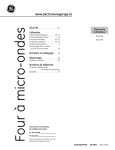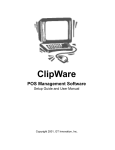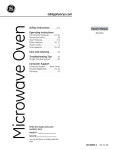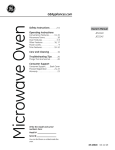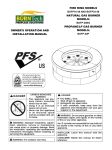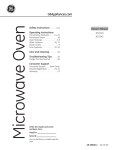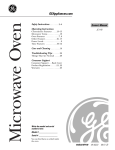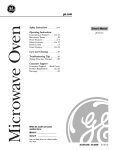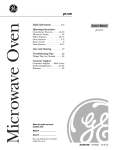Download GE JES1145WTC microwave
Transcript
Microwave Oven GEAppliances.ca Safety Instructions. . . . . . . . 2–6 Owner’s Manual Operating Instructions JES1140 JES1145 Convenience Features. . . . . . . 13–15 Microwave Terms . . . . . . . . . . . . . . 18 Oven Features . . . . . . . . . . . . . . . . 7, 8 Other Features. . . . . . . . . . . . . . 16, 17 Power Levels. . . . . . . . . . . . . . . . . . . . . 9 Time Features. . . . . . . . . . . . . . . 10–12 Care and Cleaning . . . . . . . . . 19 Troubleshooting Tips . . . . . . 20 Things That Are Normal . . . . . . . . 20 Consumer Support Service Telephone Numbers .. . . . . . . . . . . . . . . . . . . . . . . . Back Cover Warranty. . . . . . . . . . . . . . . . . . . . . . 23 Write the model and serial numbers here: Model #___________________ Serial #____________________ You can find them on a label inside the oven. 350A4502P746 29-5907 08-13 ATS IMPORTANT SAFETY INSTRUCTIONS. READ ALL INSTRUCTIONS BEFORE USING. WARNING! For your safety, the information in this manual must be followed to minimize the risk of fire or explosion, electric shock, or to prevent property damage, personal injury, or loss of life. PRECAUTIONS TO AVOID POSSIBLE EXPOSURE TO EXCESSIVE MICROWAVE ENERGY (a) Do Not Attempt to operate this oven with the door open since open-door operation can result in harmful exposure to microwave energy. It is important not to defeat or tamper with the safety interlocks. ( b) Do Not Place any object between the oven front face and the door or allow soil or cleaner residue to accumulate on sealing surfaces. (c) D o Not Operate the oven if it is damaged. It is particularly important that the oven door close properly and that there is no damage to the: (1) door (bent), (2) hinges and latches (broken or loosened), (3) door seals and sealing surfaces. (d) T he Oven Should Not be adjusted or repaired by anyone except properly qualified service personnel. IMPORTANT SAFETY INSTRUCTIONS. Use this appliance only for its intended purpose as described in this Owner’s Manual. When using electrical appliances basic safety precautions should be followed, including the following: n Read and follow the specific precautions in the Precautions to Avoid Possible Exposure to Excessive Microwave Energy section above. n This appliance must be grounded. Connect only to a properly grounded outlet. See the Grounding Instructions section on page 5. nInstall or locate this appliance only in accordance with the provided installation instructions. n Be certain to place the front surface of the door 3" (7.6 cm) or more back from the countertop edge to avoid accidental tipping of the appliance in normal usage. n This microwave oven is not approved or tested for marine use. nDo not mount this appliance over a sink. nDo not mount the microwave oven over or near any portion of a heating or cooking appliance. nDo not store anything directly on top of the microwave oven surface when the microwave oven is in operation. nDo not operate this appliance if it has a damaged power cord or plug, if it is not working properly, or if it has been damaged or dropped. nDo not cover or block any openings on the appliance. nUse this appliance only for its intended use as described in this manual. Do not use corrosive chemicals or vapors in this appliance. This microwave oven is specifically designed to heat, dry or cook food, and is not intended for laboratory or industrial use. nDo not store this appliance outdoors. Do not use this product near water—for example, in a wet basement, near a swimming pool, near a sink or in similar locations. 2 n Keep power cord away from heated surfaces. nDo not immerse power cord or plug in water. nDo not let power cord hang over edge of table or counter. n To reduce the risk of fire in the oven cavity: — Do not overcook food. Carefully attend appliance when paper, plastic or other combustible materials are placed inside the oven while cooking. — Remove wire twist-ties and metal handles from paper or plastic containers before placing them in the oven. — Do not use the oven for storage purposes. Do not leave paper products, cooking utensils or food in the oven when not in use. — If materials inside the oven ignite, keep the oven door closed, turn the oven off and disconnect the power cord, or shut off power at the fuse or circuit breaker panel. If the door is opened, the fire may spread. n See door surface cleaning instructions in the Care and cleaning of the microwave oven section of this manual. n This appliance must only be serviced by qualified service personnel. Contact the nearest authorized service facility for examination, repair or adjustment. n As with any appliance, close supervision is necessary when used by children. SAVE THESE INSTRUCTIONS GEAppliances.ca WARNING! ARCING If you see arcing, press the CLEAR/OFF pad and correct the problem. Arcing is the microwave term for sparks in the oven. Arcing is caused by: n Metal, such as twist-ties, poultry pins or goldrimmed dishes, in the microwave. n Metal or foil touching the side of the oven. n Recycled paper towels containing small metal pieces being used in the microwave. n Foil not molded to food (upturned edges act like antennas). FOODS nDo not pop popcorn in your microwave oven unless in a special microwave popcorn accessory or unless you use popcorn labeled for use in microwave ovens. n Some products such as whole eggs and sealed containers—for example, closed jars—are able to explode and should not be heated in this microwave oven. Such use of the microwave oven could result in injury. nDo not boil eggs in a microwave oven. Pressure will build up inside egg yolk and will cause it to burst, possibly resulting in injury. n Operating the microwave with no food inside for more than a minute or two may cause damage to the oven and could start a fire. It increases the heat around the magnetron and can shorten the life of the oven. n Foods with unbroken outer “skin” such as potatoes, hot dogs, sausages, tomatoes, apples, chicken livers and other giblets and egg yolks should be pierced to allow steam to escape during cooking. n Avoid heating baby food in glass jars, even with the lid off. Make sure all infant food is thoroughly cooked. Stir food to distribute the heat evenly. Be careful to prevent scalding when warming formula. The container may feel cooler than the formula really is. Always test the formula before feeding the baby. n Don’t defrost frozen beverages in narrow-necked bottles (especially carbonated beverages). Even if the container is opened, pressure can build up. This can cause the container to burst, possibly resulting in injury. n Superheated water Liquids, such as water, coffee or tea are able to be overheated beyond the boiling point without appearing to be boiling. Visible bubbling or boiling when the container is removed from the microwave oven is not always present. This could result in very hot liquids suddenly boiling over when the container is disturbed or a spoon or other utensil is inserted into the liquid. To reduce the risk of injury to persons: — Do not overheat the liquid. — Stir the liquid both before and halfway through heating it. — Do not use straight-sided container with narrow necks. — After heating, allow the container to stand in the microwave oven for a short time before removing the container. — Use extreme care when inserting a spoon or other utensil into the container. n Hot foods and steam can cause burns. Be careful when opening any containers of hot food, including popcorn bags, cooking pouches and boxes. To prevent possible injury, direct steam away from hands and face. nDo not overcook potatoes. They could dehydrate and catch fire, causing damage to your oven. n Cook meat and poultry thoroughly—meat to at least an INTERNAL temperature of 160°F (71°C) and poultry to at least an INTERNAL temperature of 180°F (82°C). Cooking to these temperatures usually protects against foodborne illness. 3 IMPORTANT SAFETY INFORMATION. READ ALL INSTRUCTIONS BEFORE USING. WARNING! MICROWAVE-SAFE COOKWARE Make sure all cookware used in your microwave oven is suitable for microwaving. Most glass casseroles, cooking dishes, measuring cups, custard cups, pottery or china dinnerware which does not have metallic trim or glaze with a metallic sheen can be used. Some cookware is labeled “suitable for microwaving.” n If you are not sure if a dish is microwave-safe, use this test: Place in the oven both the dish you are testing and a glass measuring cup filled with 1 cup (240 mL) of water—set the measuring cup either in or next to the dish. Microwave 30–45 seconds at high. If the dish heats, it should not be used for microwaving. If the dish remains cool and only the water in the cup heats, then the dish is microwave-safe. nIf you use a meat thermometer while cooking, make sure it is safe for use in microwave ovens. nDo not use recycled paper products. Recycled paper towels, napkins and waxed paper can contain metal flecks which may cause arcing or ignite. Paper products containing nylon or nylon filaments should be avoided, as they may also ignite. n Some styrofoam trays (like those that meat is packaged on) have a thin strip of metal embedded in the bottom. When microwaved, the metal can burn the floor of the oven or ignite a paper towel. nDo not use the microwave to dry newspapers. n Not all plastic wrap is suitable for use in microwave ovens. Check the package for proper use. n Paper towels, waxed paper and plastic wrap can be used to cover dishes in order to retain moisture and prevent spattering. Be sure to vent plastic wrap so steam can escape. 4 n Cookware may become hot because of heat transferred from the heated food. Pot holders may be needed to handle the cookware. n “Boilable” cooking pouches and tightly closed plastic bags should be slit, pierced or vented as directed by package. If they are not, plastic could burst during or immediately after cooking, possibly resulting in injury. Also, plastic storage containers should be at least partially uncovered because they form a tight seal. When cooking with containers tightly covered with plastic wrap, remove covering carefully and direct steam away from hands and face. nUse foil only as directed in this guide. TV dinners may be microwaved in foil trays less than 3/4" (1.9 cm) high; remove the top foil cover and return the tray to the box. When using foil in the microwave oven, keep the foil at least 1" (2.5 cm) away from the sides of the oven. n Plastic cookware—Plastic cookware designed for microwave cooking is very useful, but should be used carefully. Even microwave-safe plastic may not be as tolerant of overcooking conditions as are glass or ceramic materials and may soften or char if subjected to short periods of overcooking. In longer exposures to overcooking, the food and cookware could ignite. Follow these guidelines: Use microwave-safe plastics only and use them in strict compliance with the cookware manufacturer’s recommendations. 1 2 Do not microwave empty containers. not permit children to use plastic cookware 3 Do without complete supervision. GEAppliances.ca GROUNDING INSTRUCTIONS WARNING—Improper use of the grounding plug can result in a risk of electric shock. This appliance must be grounded. In the event of an electrical short circuit, grounding reduces the risk of electric shock by providing an escape wire for the electric current. If the outlet is a standard 2-prong wall outlet, it is your personal responsibility and obligation to have it replaced with a properly grounded 3-prong wall outlet. This appliance is equipped with a power cord having a grounding wire with a grounding plug. The plug must be plugged into an outlet that is properly installed and grounded. Do not under any circumstances cut or remove the third (ground) prong from the power cord. Consult a qualified electrician or service technician if the grounding instructions are not completely understood, or if doubt exists as to whether the appliance is properly grounded. We do not recommend using an extension cord with this appliance. If the power cord is too short, have a qualified electrician or service technician install an outlet near the appliance. (See EXTENSION CORDS section.) For best operation, plug this appliance into its own electrical outlet to prevent flickering of lights, blowing of fuse or tripping of circuit breaker. ADAPTER PLUGS Usage situations where appliance’s power cord will be disconnected infrequently. Because of potential safety hazards under certain conditions, we strongly recommend against the use of an adapter plug. However, if you still elect to use an adapter, where local codes permit, a TEMPORARY CONNECTION may be made to a properly grounded wall receptacle by the use of a UL listed adapter which is available at most local hardware stores. (Adapter plugs not permitted in Canada) The larger slot in the adapter must be aligned with the larger slot in the wall receptacle to provide proper polarity in the connection of the power cord. TEMPORARY METHOD Align large prongs/slots Ensure proper ground and firm connection before use. CAUTION: Attaching the adapter ground terminal to the wall receptacle cover screw does not ground the appliance unless the cover screw is metal, and not insulated, and the wall receptacle is grounded through the house wiring. You should have the circuit checked by a qualified electrician to make sure the receptacle is properly grounded. When disconnecting the power cord from the adapter, always hold the adapter with one hand. If this is not done, the adapter ground terminal is very likely to break with repeated use. Should this happen, DO NOT USE the appliance until a proper ground has again been established. Usage situations where appliance’s power cord will be disconnected frequently. Do not use an adapter plug in these situations because frequent disconnection of the power cord places undue strain on the adapter and leads to eventual failure of the adapter ground terminal. You should have the 2-prong wall receptacle replaced with a 3-prong (grounding) receptacle by a qualified electrician before using the appliance. 5 IMPORTANT SAFETY INFORMATION. READ ALL INSTRUCTIONS BEFORE USING. WARNING! EXTENSION CORDS A short power supply cord is provided to reduce the risks resulting from becoming entangled in or tripping over a longer cord. Extension cords may be used if you are careful in using them. If an extension cord is used— The marked electrical rating of the extension cord should be at least as great as the electrical rating of the appliance; 1 2 The extension cord must be a grounding-type 3-wire cord and it must be plugged into a 3-slot outlet; extension cord should be arranged so that it will not drape over the countertop or tabletop where it 3 The can be pulled on by children or tripped over unintentionally. If you use an extension cord, the interior light may flicker and the blower sound may vary when the microwave oven is on. Cooking times may be longer, too. Read and follow this Safety Information carefully. SAVE THESE INSTRUCTIONS 6 About the features of your microwave oven. GEAppliances.ca Throughout this manual, features and appearance may vary from your model. 1100 Watts Features of the Oven Door Latches. Door Latch Release. Press latch release to open door. Window with Metal Shield. Screen allows cooking to be viewed while keeping microwaves confined in the oven. Removable Turntable. Turntable and support must be in place when using the oven. The turntable may be removed for cleaning. Convenience Guide. Removable Turntable Support. The turntable support must be in place when using the oven. Touch Control Panel Display. NOTE: Rating plate, oven vent(s) and oven light are located on the inside walls of the microwave oven. 7 About the features of your microwave oven. You can microwave by time or with the convenience features. Not all features on all models. Popcorn Potato Pizza Beverage Reheat Vegetable Time Power Auto Time Cook Level Defrost Defrost Express Cook 1 2 3 4 5 6 7 8 9 Timer 0 Clock Clear Add 30 Sec Pause Off Start Cooking Controls Check the Convenience Guide before you begin (not all features are available on all models).. Time Features PressEnter Time Cook Amount of cooking time Press number pads TIME DEFROST Amount of defrosting time POWER LEVEL Power level 10 to 1 EXPRESS COOK Starts immediately! Convenience Features 8 PressEnter POPCORN Starts immediately! Press once, or twice Option 3.5 oz. or 3 oz. (100 g or 85 g) BEVERAGE Starts immediately! Press once, twice, three or four times REHEATEnter food code Press once see Cooking Guide TIME COOKEnter Cooking Time Press once TIME DEFROSTEnter Defrost Time PIZZA Starts immediately! Press 1-4 times 8 oz., 12 oz., 16 oz. or 4 oz. (236 mL, 355 mL, 473 mL or 118 mL) GEAppliances.ca Time Cook Changing the Power Level Power Level The power level must be entered or changed after entering the time for Time Cook. Express Cook 1 2 3 4 5 6 7 8 9 0 Start Pause ress TIME COOK and enter cooking 1 Ptime. ress POWER LEVEL and select power 2 Plevel 10-1. 3 Press START. Variable power levels add flexibility to microwave cooking. The power levels on the microwave oven can be compared to the surface units on a range. Each power level gives you microwave energy a certain percent of the time. Power level 7 is microwave energy 70% of the time. Power level 3 is energy 30% of the time. Most cooking will be done on 10 which gives you 100% power. Power level 10 will cook faster but food may need more frequent stirring, rotating or turning over. A lower setting will cook more evenly and need less stirring or rotating of the food. Some foods may have better flavor, texture or appearance if one of the lower settings is used. Use a lower power level when cooking foods that have a tendency to boil over, such as scalloped potatoes. Rest periods (when the microwave energy cycles off) give time for the food to “equalize” or transfer heat to the inside of the food. An example of this is shown with power level 3—the defrost cycle. If microwave energy did not cycle off, the outside of the food would cook before the inside was defrosted. Here are some examples of uses for various power levels: HI 10: Fish, bacon, vegetables, boiling liquids. Med-High 7: Gentle cooking of meat and poultry; baking casseroles and reheating. Medium 5: Slow cooking and tenderizing for stews and less tender cuts of meat. Low 2 or 3: Defrosting; simmering; delicate sauces. Warm 1: Keeping food warm; softening butter. 9 About the time features. Time Cook Time Cook Allows you to microwave for any time up to 99 minutes and 99 seconds. Express Cook 1 2 3 4 5 6 7 8 9 0 HI power level (10) is automatically set, but you may change it for more flexibility. 1 Press TIME COOK. 2 Enter cooking time. 3 Press START. You may open the door during Time Cook to check the food. Close the door and press START to resume cooking. Start Pause Express Cook Express Cook 1 2 3 4 5 6 This is a quick way to set cooking time fro 1-6 minutes. ress one of the Express Cook pads (from 1-6) for 1-6 minutes of cooking at 1 Ppower level 10. For example, press the 2 pad for 2 minutes of cooking time. The power level can be changed as time is counting down. Press POWER LEVEL and enter 1-10. NOTE: Express Cook function pertains to pads 1-6 only. Add 30 Sec Add 30 Sec 10 It will add 30 seconds to the time counting down each time the pad is pressed. Each touch will add 30 seconds, up to 99 minutes and 99 seconds. The oven will start immediately when pressed. GEAppliances.ca Pre-set Meals Feature (on some models) Allows you to microwave healthy food choices by servings. HI (10) power level is automatically set, but you may change it for more flexibility. Express Cook 1 2 3 4 5 6 7 8 9 0 1 Press Pre-set meals pad. 2 Enter the food code. See Cooking Guide for Pre-set Meals below for codes. nter the number of servings (1-4). Then 3 Ethe microwave will start immediately. You may open the door during cooking to check the food. Close the door and press START to resume cooking. Cooking Guide for Pre-set Meals Feature NOTE: Use HI (10) power level unless otherwise noted. Enter Code Food Choice 1 2 3 4 5 6 7 8 9 Rice Oatmeal Pasta Asparagus Broccoli Green Beans Corn Potato Green Peas Available Serving Selection 1-4 1-4 1-4 1-4 1-4 1-4 1-4 1-4 1-4 Ounces per serving 4 oz (118 mL) per serving 4 oz (118 mL) per serving 4 oz (118 mL) per serving 4 oz (118 mL) per serving 4 oz (118 mL) per serving 4 oz (118 mL) per serving 4 oz (118 mL) per serving 4 oz (118 mL) per serving 4 oz (118 mL) per serving 11 About the convenience features. Time Defrost (on some models) Time Allows you to defrost for a selected length of time. See the Defrosting Guide for suggested times. (Auto Defrost explained in the About the convenience features section.) Defrost Express Cook 1 2 3 4 5 6 7 8 9 0 Start Pause 1 Press TIME DEFROST. 2 Enter defrosting time. 3 Press START. 4 Turn the food over after half the time. 5 Press START. At one half of selected defrosting time, turn food over and break apart or rearrange pieces for more even defrosting. Shield any warm areas with small pieces of foil. The oven will continue to defrost if you don’t open the door and turn the food. A dull thumping noise may be heard during defrosting. This is normal when oven is not operating at HI (10) power. Defrosting Tips n Foods frozen in paper or plastic can be defrosted in the package. Closed packages should be slit, pierced or vented AFTER food has partially defrosted. Plastic storage containers should be partially uncovered. n Family-size, prepackaged frozen dinners can be defrosted and microwaved. If the food is in a foil container, transfer it to a microwave-safe dish. n Foods that spoil easily should not be allowed to sit out for more than one hour after defrosting. Room temperature promotes the growth of harmful bacteria. n For more even defrosting of larger foods, such as roasts, use Auto Defrost. Be sure large meats are completely defrosted before cooking. n When defrosted, food should be cool but softened in all areas. If still slightly icy, return to the microwave very briefly, or let it stand a few minutes. Defrosting Guide Food TimeComments Breads, Cakes Bread, buns, or rolls (1 piece) Sweet rolls (approx. 12 oz./340 g) 1/4 min. 2 to 4 min. Fish and Seafood Fillets, frozen (1 lb./454 g) 6 to 9 min. Shellfish, small pieces (1 lb./454 g) 3 to 7 min. Fruit Plastic pouch—1 or 2 (10-oz./283 g package) Meat Bacon (1 lb./454 g) Rearrange after half the time. Place block in casserole. Turn over and break up after half the time. 1 to 5 min. 2 to 5 min. Place unopened package in oven. Let stand 5 minutes after defrosting. Franks (1 lb./454 g) 2 to 5 min. Place unopened package in oven. Microwave just until franks can be separated. Let stand 5 minutes, if necessary, to complete defrosting. Ground meat (1 lb./454 g) 4 to 6 min. Turn meat over after first half of time. Roast: beef, lamb, veal, pork 9 to 13 min. per lb./454 g Turn meat over after first half of time. Steaks, chops and cutlets 4 to 8 min. per lb./454 g Place unwrapped meat in cooking dish. Turn over after first half of time and shield warm areas with foil. After second half of time, separate pieces with table knife. Let stand to complete defrosting. Poultry 14 to 20 min. Chicken, broiler-fryer, cut up (21⁄2 to 3 lbs./1.1 to 1.4 kg) Chicken, whole 20 to 25 min. (21⁄2 to 3 lbs./1.1 to 1.4 kg) Cornish hen 7 to 13 min. per lb./454 g Turkey breast 3 to 8 min. (4 to 6 lbs./1.8 to 2.7 kg) per lb./454 g Place wrapped chicken in dish. Unwrap and turn over after first half of time. After second half of time, separate pieces and place in cooking dish. Microwave 2 to 4 minutes more, if necessary. Let stand a few minutes to finish defrosting. Place wrapped chicken in dish. After half the time, unwrap and turn chicken over. Shield warm areas with foil. To complete defrosting, run cold water in the cavity until giblets can be removed. Place unwrapped hen in the oven breast-side-up. Turn over after first half of time. Run cool water in the cavity until giblets can be removed. Place unwrapped breast in microwave-safe dish breast-side-down. After first half of time, turn breast-side-up and shield warm areas with foil. Defrost for second half of time. Let stand 1 to 2 hours in refrigerator to complete defrosting. 12 GEAppliances.ca Popcorn Use only with prepackaged microwave popcorn weighing 3.0 to 3.5 ounces (85 to 100 g). Popcorn To use the Popcorn feature: ollow package instructions, using 1 FTime Cook if the package is less than 1.75 ounces (50 g) or larger than 3.5 ounces (100 g). Place the package of popcorn in the center of the microwave. POPCORN once for a 3.0 ounce 2 Press (85 g) package of popcorn, twice for a 3.5 ounce (100 g) package. The oven starts immediately. Reheat Reheat 1 Press Reheat pad. the food code. See Cooking Guide 2 Enter for Reheat feature below for codes. nter the number of servings (1-4). Then 3 Ethe microwave will start immediately. You may open the door during cooking to check the food. Close the door and press START to resume cooking. Cooking Guide for REHEAT feature Enter Code Food Choice 1 2 3 4 5 6 Pasta Meats Veggies Beverage Sauces Plate Available Serving Selection 1-4 1-4 1-4 1-4 1-4 1-4 Ounces per serving 4 oz (118 mL) per serving 4 oz (118 mL) per serving 4 oz (118 mL) per serving 4 oz (118 mL) per serving 4 oz (118 mL) per serving 4 oz (118 mL) per serving 13 About the convenience features. Beverage Beverage To use the Beverage feature: Press BEVERAGE pad. The microwave will automatically be set to heat a 4 ounce (118 mL) beverage. The microwave will start immediately. If you would like to change the the setting for the beverage size: press the BEVERAGE pad for 1 Repeatedly the following serving size: Ounces per Serving 4 ounces (118 mL) 8 ounces (237 mL) 12 ounces (355 mL) 16 ounces (473 mL) 2 The microwave will start immediately. Pizza Pizza (on some models) To use the Pizza feature: Press PIZZA pad. The microwave will automatically be set to heat 1 piece of pizza. The microwave will start immediately. If you would like to change the the setting for a different amount of servings: press the PIZZA pad for the 1 Repeatedly following serving size: No. of Servings 1 Piece of Pizza 2 pieces of Pizza 3 pieces of Pizza 4 pieces of Pizza 2 The microwave will start immediately. 14 Drinks heated with the Beverage feature may be very hot. Remove the container with care. GEAppliances.ca Potato Potato (on some models) To use the Potato feature: press the POTATO pad for 1 R1-4epeatedly servings. The oven will start immediately. Vegetable Vegetable (on some models) To use the Vegetable feature:. 1 Press VEGETABLE pad. the Vegetable code. See Cooking 2 Enter Guide for Vegetables below for codes. nter the number of servings (1-4). Then 3 Ethe microwave will start immediately. Cooking Guide for VEGETABLE Feature Auto Defrost Start Pause Vegetable Code Type of Vegetables Available Serving Selection Ounces per Serving 1 Fresh 1-4 Servings 4 oz (118 mL) per serving 2 Frozen 1-4 Servings 4 oz (118 mL) per serving 3 Canned 1-4 Servings 4 oz (118 mL) per serving Auto Defrost or Defrost Use Auto Defrost/Defrost for meat, poultry and fish weighing up to 6 pounds (2.7 kg). Use Time Defrost (on some models) for most other frozen foods. There is a handy guide located on the inside front of the oven. Auto Defrost automatically sets the defrosting times and power levels to give even defrosting results for meats, poultry and fish. AUTO DEFROST/DEFROST. Use the 1 Press number pad to select 1 to 6 pounds (454 g to 2.7 kg). 2 Press START. (Time Defrost is explained in the About the time features section.) n Remove meat from package and place on microwave-safe dish. n When the oven signals, turn the food over. Remove defrosted meat or shield warm areas with small pieces of foil. n After defrosting, most meats need to stand 5 minutes to complete defrosting. Large roasts should stand for about 30 minutes. 15 About the other features. Clock (12 Hour Clock) Clock Press to enter the time of day. Express Cook 1 2 3 4 5 6 7 8 9 1 Press CLOCK. 2 Enter time of day. 3 Press CLOCK. 0 Start Pause Start Pause Clear Off Pause START/PAUSE allows you to stop cooking without opening the door or clearing the display. Press START/PAUSE again to restart the oven. Child Lock-Out You may lock the control panel to prevent the microwave from being accidentally started or used by children. To lock or unlock the controls, press and hold CLEAR/OFF for about three seconds. When the control panel is locked, the lock indicator will be lit. 16 GEAppliances.ca Timer Timer This pad performs the following functions: nIt operates as a minute timer. nIt can be used as a hold setting after defrosting. How to Use as a Minute Timer The Timer operates without microwave energy. 1 Press TIMER. 2 Enter the amount of time you want to count down. 3 Press TIMER. When the time is up, the timer will signal. 17 Microwave terms. TermDefinition Arcing Arcing is the microwave term for sparks in the oven. Arcing is caused by: n metal or foil touching the side of the oven. n foil that is not molded to food (upturned edges act like antennas). n metal such as twist-ties, poultry pins, gold-rimmed dishes. n recycled paper towels containing small metal pieces. Covering Covers hold in moisture, allow for more even heating and reduce cooking time. Venting plastic wrap or covering with wax paper allows excess steam to escape. Shielding In a regular oven, you shield chicken breasts or baked foods to prevent over-browning. When microwaving, you use small strips of foil to shield thin parts, such as the tips of wings and legs on poultry, which would cook before larger parts. Standing Time When you cook with regular ovens, foods such as roasts or cakes are allowed to stand to finish cooking or to set. Standing time is especially important in microwave cooking. Note that a microwaved cake is not placed on a cooling rack. Venting 18 After covering a dish with plastic wrap, you vent the plastic wrap by turning back one corner so excess steam can escape. Care and cleaning of the microwave oven. GEAppliances.ca Helpful Hints An occasional thorough wiping with a solution of baking soda and water keeps the inside fresh. Unplug the cord before cleaning any part of this oven. How to Clean the Inside Walls, Floor, Inside Window, Metal and Plastic Parts on the Door Some spatters can be removed with a paper towel; others may require a damp cloth. Remove greasy spatters with a sudsy cloth, then rinse with a damp cloth. Do not use abrasive cleaners or sharp utensils on oven walls. To clean the surface of the door and the surface of the oven that come together upon closing, use only mild, nonabrasive soaps or detergents using a sponge or soft cloth. Rinse with a damp cloth and dry. Never use a commercial oven cleaner on any part of your microwave. Removable Turntable and Turntable Support To prevent breakage, do not place the turntable into water just after cooking. Wash it carefully in warm, sudsy water or in the dishwasher. The turntable and support can be broken if dropped. Remember, do not operate the oven without the turntable and support in place. How to Clean the Outside Do not use cleaners containing ammonia or alcohol on the microwave oven. Ammonia or alcohol can damage the appearance of the microwave. Case Clean the outside of the microwave with a sudsy cloth. Rinse with a damp cloth and then dry. Wipe the window clean with a damp cloth. Control Panel and Door Wipe with a damp cloth. Dry thoroughly. Do not use cleaning sprays, large amounts of soap and water, abrasives or sharp objects on the panel—they can damage it. Some paper towels can also scratch the control panel. Door Surface It is important to keep the area clean where the door seals against the microwave. Use only mild, non-abrasive detergents applied with a clean sponge or soft cloth. Rinse well. Power Cord If the cord becomes soiled, unplug and wash with a damp cloth. For stubborn spots, sudsy water may be used, but be certain to rinse with a damp cloth and dry thoroughly before plugging cord into outlet. Stainless Steel (on some models) Do not use a steel-wood pad; it will scratch the surface. To clean the stainless steel surface, use a hot, damp cloth with a mild detergent suitable for stainless steel surfaces. Use a clean, hot, damp cloth to remove soap. Dry with a dry, clean cloth. Always scrub lightly in the direction of the grain. 19 Troubleshooting Tips. Problem Possible Causes What To Do Oven will not start A fuse in your home may be blown or the circuit breaker tripped. •Replace fuse or reset circuit breaker. Power surge. •Unplug the microwave oven, then plug it back in. Plug not fully inserted into wall •Make sure the 3-prong plug on the oven is fully inserted outlet. into wall outlet. Door not securely closed. •Open the door and close securely. Control panel lighted, yet oven will not start Door not securely closed. •Open the door and close securely. Another selection entered already in oven and CLEAR/OFF pad not pressed to cancel it. CLEAR/OFF was pressed •Reset cooking program and press START. accidentally. Microwave oven control will not work The control has been locked. •Press and hold CLEAR/OFF for about three seconds (When the control panel is to unlock the control. locked, the lock indicator will be lit.) START pad not pressed after •Press START. entering cooking selection. •Press CLEAR/OFF. Things That Are Normal With Your Microwave Oven n Steam or vapor escaping from around the door. n Light reflection around door or outer case. nDimming oven light and change in the blower sound at power levels other than high. nDull thumping sound while oven is operating. 20 n TV/radio interference might be noticed while using the microwave. Similar to the interference caused by other small appliances, it does not indicate a problem with the microwave. Plug the microwave into a different electrical circuit, move the radio or TV as far away from the microwave as possible, or check the position and signal of the TV/radio antenna. Notes. GEAppliances.ca 21 Notes. 22 GE MICROWAVE OVEN WARRANTY All warranty service provided by our Factory Service Centers, or an authorized Customer Care® technician during normal working hours. For service, call 1-800-561-3344. GEAppliances.ca Staple your receipt here. Proof of the original purchase date is needed to obtain service under the warranty. For The Period Of: Mabe Will Replace: One Year Any part of the microwave oven which fails due to a defect in materials or workmanship. During From the date of thethis full one-year warranty, Mabe will also provide, free of charge, all labour and related service original purchase costs to repair or replace the defective part. What Mabe Will Not Cover: n Service trips to your home to teach you how to use the product. nIncidental or consequential damage to personal property caused by possible defects with this appliance. nImproper installation. Read your Use & Care Material: n Failure of the product if it is abused, misused, or used for other than the intended purpose or used commercially. If you then have any questions about operating the product, please contact your dealer or our Consumer Affairs office at the address below, or call toll free: n Replacement of house fuses or resetting of circuit breakers. nDamage to the product caused by accident, fire, floods or acts of God. Mabe Canada Inc. 1-800-561-3344 Consumer Information Service This warranty is extended to the original purchaser and any succeeding owner for products purchased for use in Canada. Some provinces do not allow the exclusion or limitation of incendental or consequential damages, so the above limitation or exclusion may not apply to you. This warranty gives you specific legal rights, and you may also have other rights which vary from province to province. To know what your legal rights are in your province, consult your local or provincial consumer affairs office. Warrantor: Mabe Canada Inc. If further help is needed concerning this warranty, write; Consumer Relations Manager - Mabe Canada Inc. 1 Factory Lane, Suite 310, Moncton NB E1C 9M3 23 Service Telephone Numbers. In-Home Repair Service 1-800-561-3344 Expert Mabe repair service is only a phone call away. Product Satisfaction If you are not satisfied with the service you receive from Mabe, follow these steps. First, contact the people who serviced your appliance. Next, if you are still not pleased, write all the details– including your phone number–to: Manager, Consumer Relations, Mabe Canada Inc., Suite 310, 1 Factory Lane, Moncton, NB E1C 9M3. Printed in China 350A4502P685 JES1140 JES1145
























